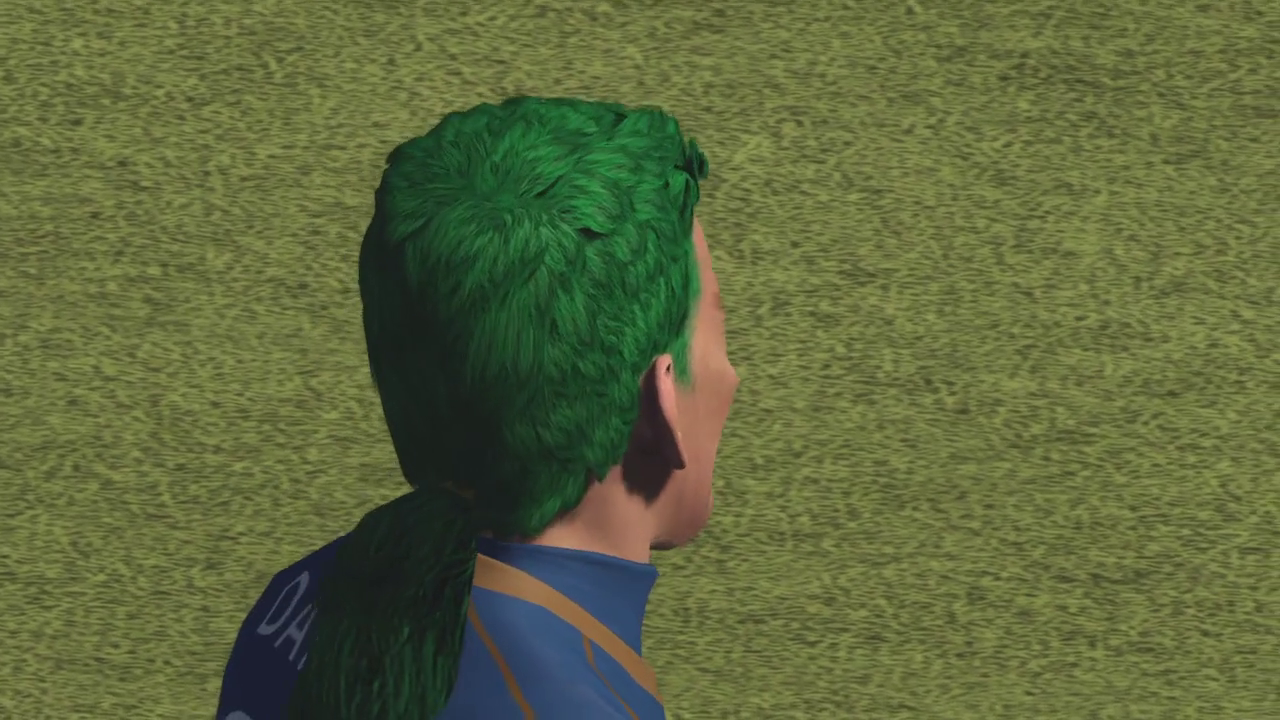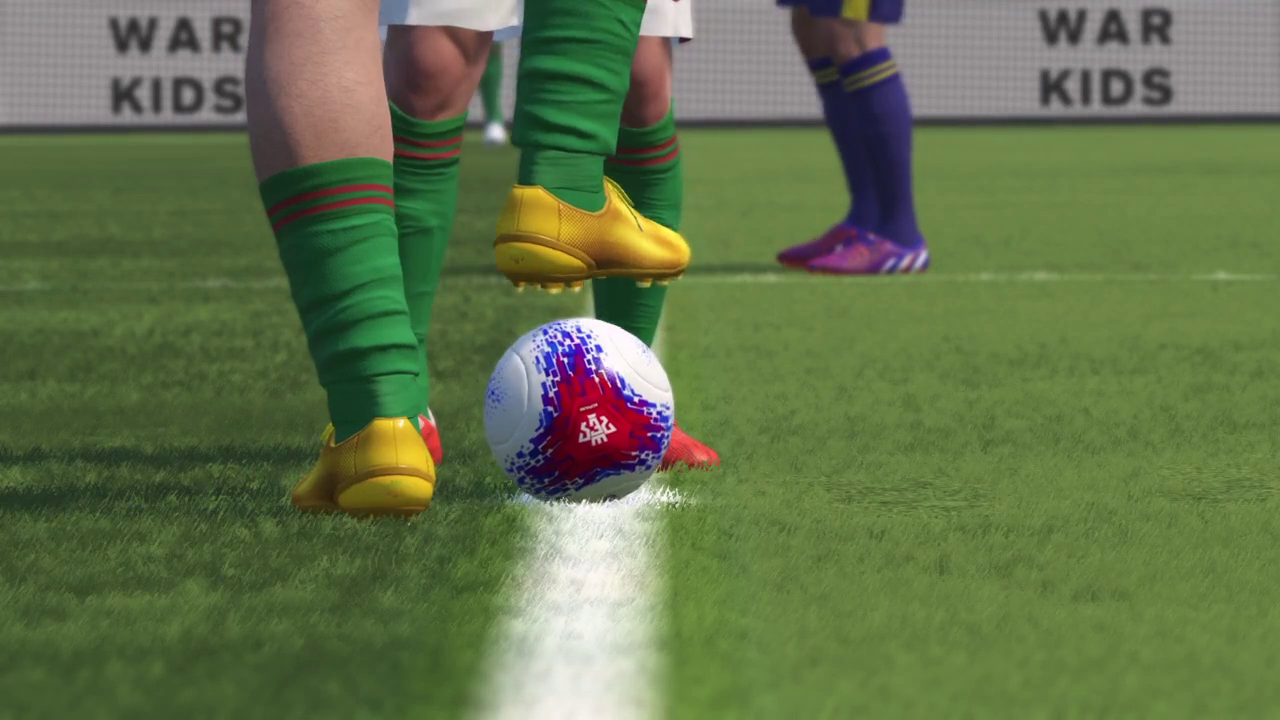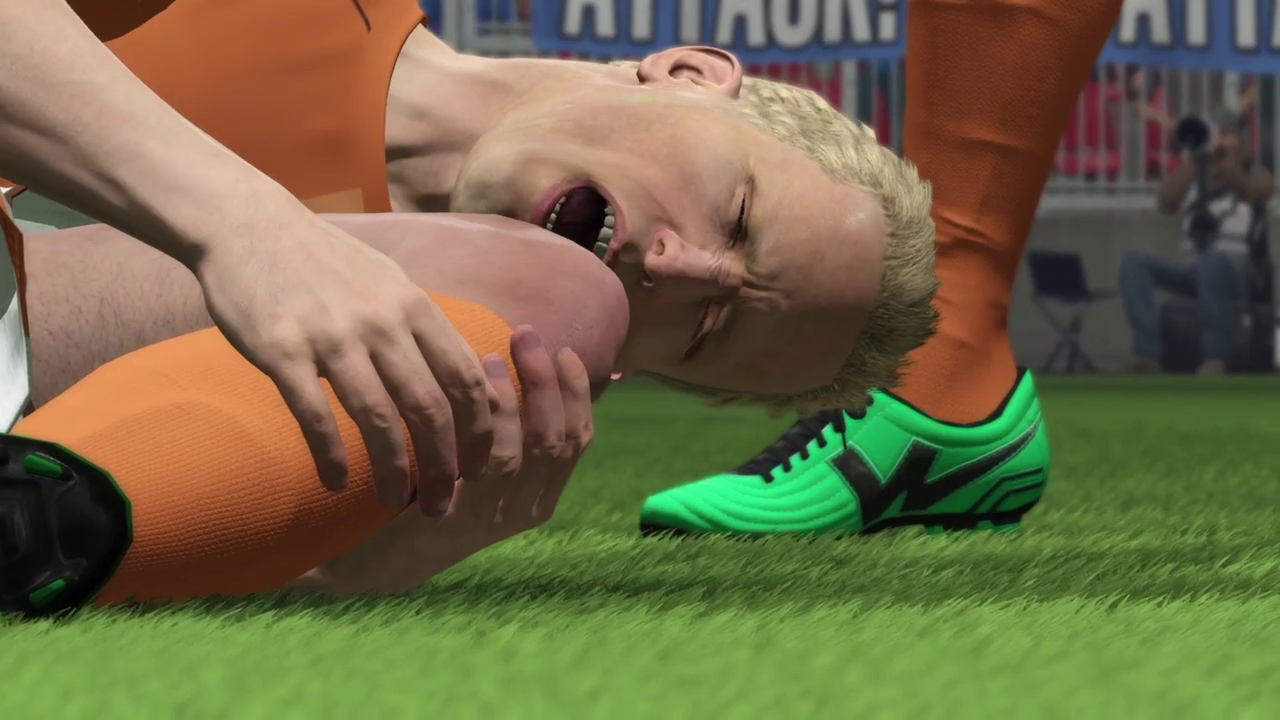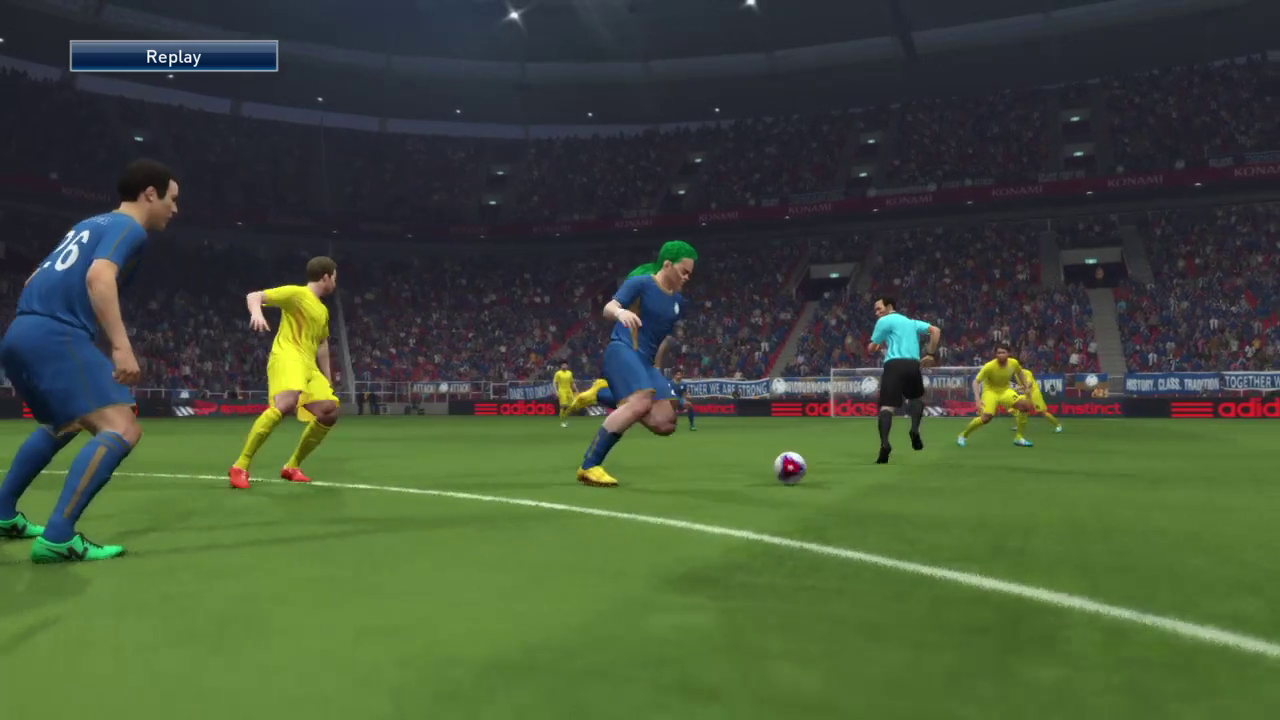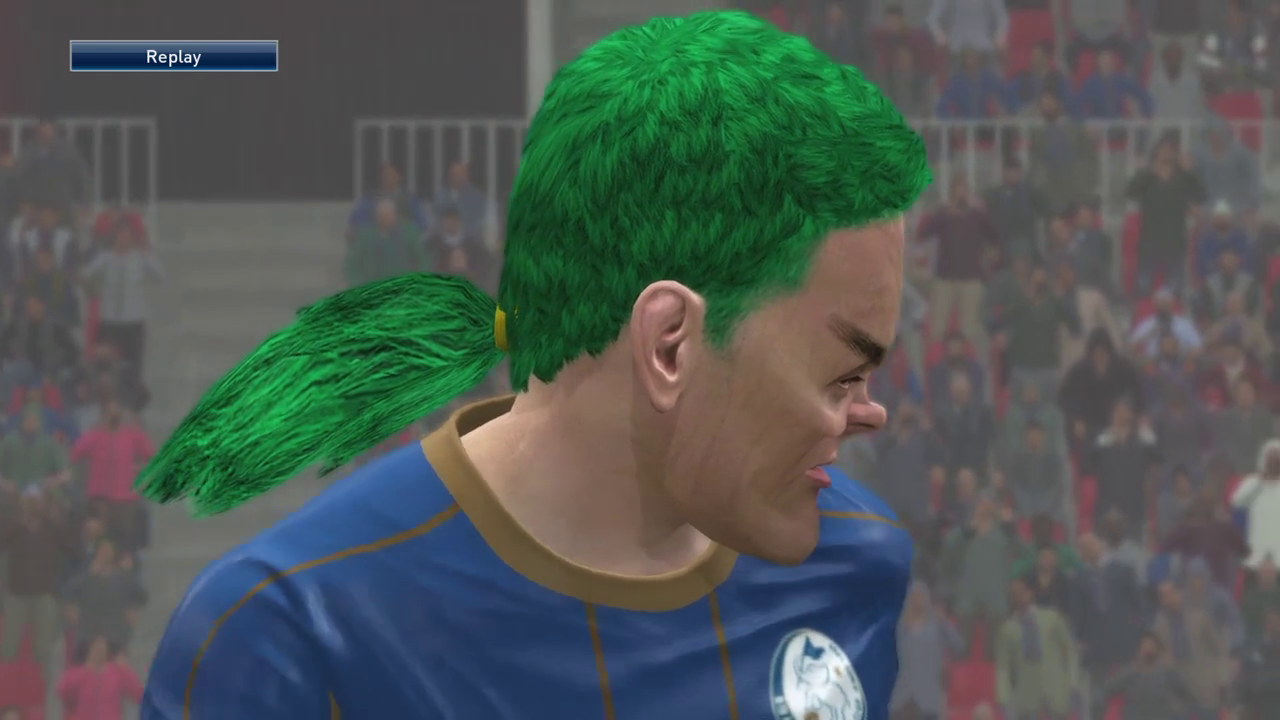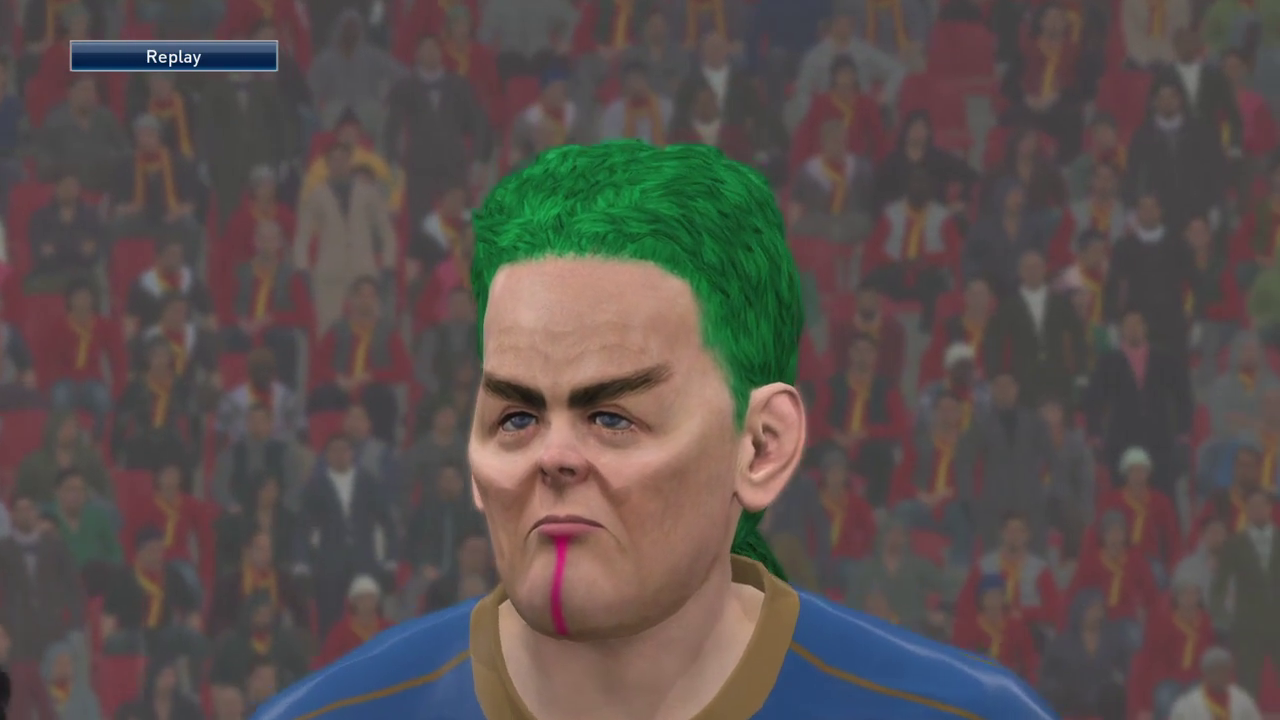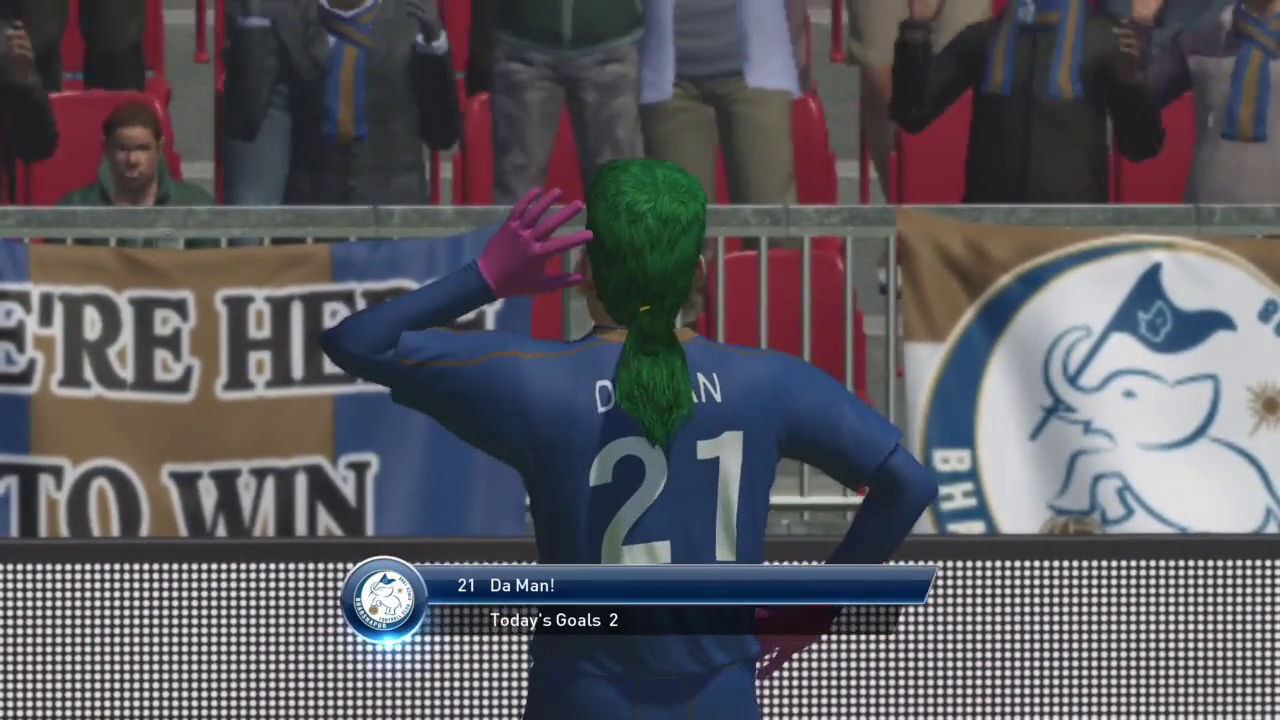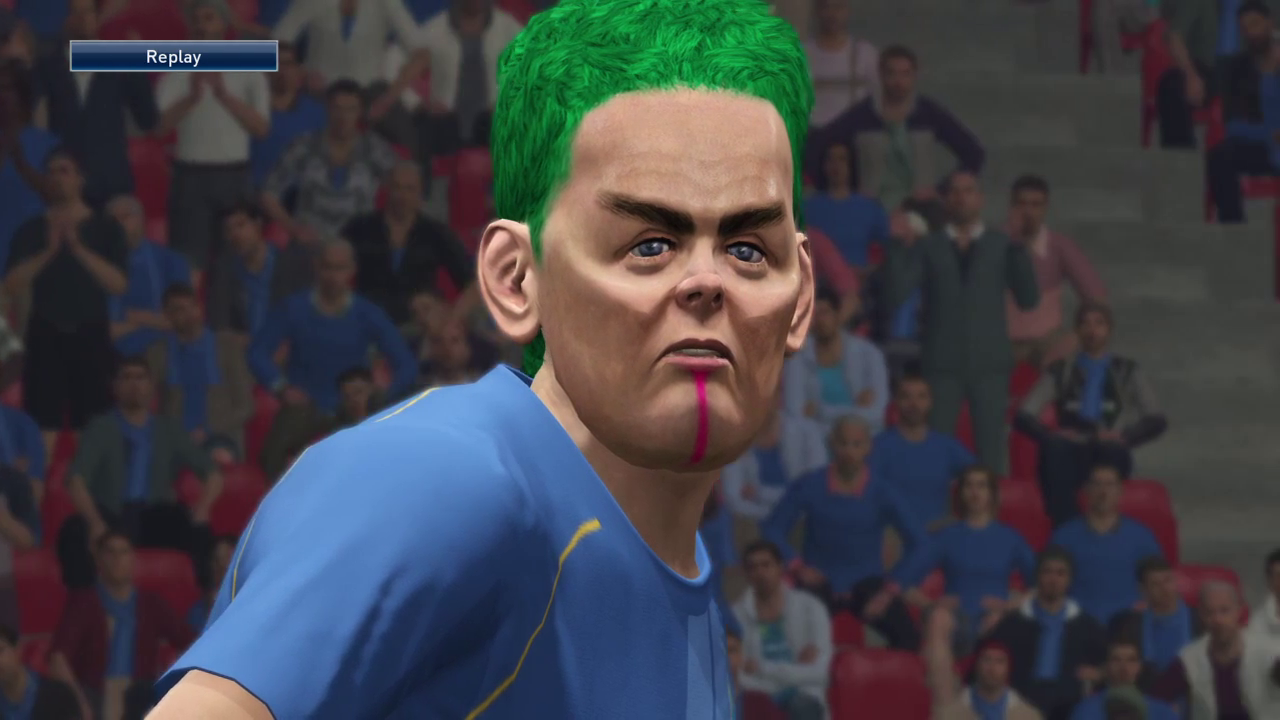BECOMING A LEGEND
digital video (1280 x 720), color, sound, 5’ 32’’, 2020, United Kingdom
Created by Gweni Llwyd and Owen Davies
The practice of customizing characters and assets in video games has a long tradition within vernacular as well as avant-garde subcultures. In fact, artists have often pursued this route to create their artworks. Few, however, reach the meta playful levels of Becoming a Legend which introduces the imperious character of Da Man!, a post-human, virtual übermensch, a diabolical, green-haired “divin codino”. Created with/in the popular video game Pro Evolution Soccer, Da Man! embodies the notion of toxic masculinity and the neoliberalist mantra of self-optimization.
Gweni Llwyd (she/her) is a Welsh artist based in Cardiff. Her practice reflects on a human condition caught between tactile physicality and intangible digital realms. Predominantly working in video, 3D animation, and installation, Gweni creates abstracted rhythms and narratives, mirroring the often chaotic, disjointed nature of the contemporary world by collecting, modifying and rearranging the most disparate sources and materials, including first hand and found footage, game engines and concrete artifacts. She is also co-founder of RAT TRAP, a collective of artists and musicians that find their own routes through the maze of protocols and ways of doing things.
Owen Davies (he/him) is a Welsh filmmaker based in Cardiff. Mainly working in live-action narrative film, his work revolves around the limits of human connection and interaction. Owen’s upcoming short film Arwel’s House, funded by Ffilm Cymru and the BBC, is shooting in July and will air on BBC4 in the UK later this year. The film follows the mother of a dead YouTube star as she gives tours of his childhood home in South Wales to fans from around the world. In 2018, he was shortlisted for the Armani Laboratorio where judge David Kajganich (Suspiria, The Terror) described his script Money Now as “just fantastic — a kind of moral emergency for the modern age that left me both queasy and totally fascinated.” Owen is also co-founder of Cardiff based production company Capitol Centre Pictures.
Luca Miranda: Can you briefly describe your upbringing?
Gweni Llwyd: I grew up in a small village called Y Fron, which is part of a valley called Dyffryn Nantlle in North Wales. Dyffryn Nantlle sits upon Cambrian slate deposits that are over 500 million years old, and as a result was heavily quarried in the 19th and 20th century, leaving behind huge bites in the mountain sides and not much else. I think being a part of this weird, post-industrial landscape while coming of age online set the foundation for the artwork I make now.
Owen Davies: I also grew up in a tiny village, in South Wales, called Fonmon. It’s right next to Cardiff Airport, so as a kid there were always planes to far away places flying over us. Like Gweni, I think growing up in the middle of nowhere meant I spent too much time online growing up, and definitely too much time playing video games, especially football ones.
Luca Miranda: What is the genesis of Becoming a Legend? How does this machinima fit into your oeuvre?
Owen Davies: I’ve played football games pretty obsessively since getting FIFA 2000 on my family computer as a six-year old, and still do now – I’d happily spend hours describing how my career with Bolton on FIFA 21 is currently going. I often watch the replay camera back after scoring goals and really enjoy the control it gives you, especially the ability to lock onto a specific player. I’d wanted to work with football games for a long time, and me and Gweni discussed it a lot, but the catalyst was probably watching Harun Farocki’s Parallel I-IV – it got us really excited about the possibilities of what we could do just through using video game footage. By now there’s a bit of a tradition of documentary films following one athlete through a match – Zidane: A 21st Century Portrait, John McEnroe: In the Realm of Perfection, there’s a George Best one called Football as Never Before too. And we thought it’d be cool to try one about a fictional footballer. OUR LOVE IS POWERFUL ENOUGH by Jonathan Vinel was another influence, in terms of using machinima to tell a grand, melodramatic story — in our case of this God-like figure Da Man!
Gweni Llwyd: Following a long stretch of research and conversations we generated the absurd character of Da Man! and added him to a team on the Pro Evolution Soccer game mode “Becoming a Legend”, where you play as one player on a team. We (mainly Owen as he’s the more gifted digital footballer) recorded hours of footage over a couple of months. When we felt like we had enough, we looked through it and picked out the most striking clips, and at the same time began writing the narration for Da Man!’s voice-over. I started putting together the sound piece and then we combined everything. I’ve been interested in machinima for ages and over the last few months I’ve been learning how to use Epic Games’ Unreal Engine. It blows my mind just how easy it is now to create insanely beautiful and complex video games and graphics – and all for free. There’s so much potential and I’m looking forward to continuing exploring this.
Luca Miranda: Machinima created with sports games, very popular within the vernacular, are relatively rare in the avantgarde. Why did you choose Pro Evolution Soccer specifically? Why did you decide to use video games in the first place rather than appropriating other kinds of found footage? Was the video game the ideal medium to address questions concerning rules, simulacra, and society’s obsession for physical optimization? What is your relationship to digital games?
Gweni Llwyd: Actual video gameplay felt most appropriate for the look and feel of this piece, which certainly relates to ideas around rules and limits – the piece only shows what is possible within the confines of the PES world. It was fun cutting together snippets of gameplay – the editing process felt like we were summoning Da Man! to life, as though he was a golem. I’ve been playing digital games for as long as I can remember – some of my earliest memories are of playing floppy disk based games like In Search of Dr. Riptide and GODS on an old battered computer. As a teenager I got addicted to the popular ones – The Sims, Skyrim, and the Fallout series – games I still play today. I’m not so good at football games but grew up around my brothers who were obsessed – in a FIFA related rage my younger brother once threw his Xbox controller at the TV and smashed the screen. I’m intrigued by the extremes of emotion that seem to follow football video games in particular, and the similarities to the reactions of spectators of actual football games.
Owen Davies: I play FIFA more than PES, but we felt PES was better suited to this idea. Part of it was practical in that we preferred the mechanics of how the replay camera worked, but also the look of it – it feels much more otherworldly than FIFA’s stricter dedication to realism, especially using an out of date version (the footage was recorded on PES 2015) to lend a slightly nostalgic feel to it. PES is also notorious for its lack of licensing compared to FIFA, and we liked the idea of having the action take place around all these fictional teams with strange names. It gave the work more of a mythical feel, which was something we wanted with this idea of Da Man! as a godlike figure.
Luca Miranda: Da Man! is a grotesque representation of machismo, the dominant ideology in video games, sports, and social media. His attitude seems to be shaped by an awareness of his role as both interface and symbol: the formula “work, struggle, perform” is a mantra that reflects the incessant demands of neoliberalism. Is the Da Man! a byproduct of the cult of busyness? Has amusement nowadays become another form of work, as Theodor Adorno and Max Horkheimer famously discussed in the 1940s? Were you also questioning the culture of football and the superstar male athlete as a model?
Owen Davies: Da Man! is certainly a byproduct of the cult of busyness. He represents a self that’s been over-optimised. The constant development of your statistical modifiers as measurements of physical attributes is prominent across lots of different types of games, but it feels more real in sports games as it’s an actual practice that people go through. Look at the difference between Cristiano Ronaldo’s physique when he first arrived in the Premier League as a spindly teenager, compared to the physical freak who jumps higher than the average NBA player that he is now. There’s a culture of glorifying that process. To stay with Ronaldo, there’s loads of articles online breathlessly talking about the extreme measures he takes to achieve his physical condition, like taking five 90 minute naps a day instead of a full night’s sleep, or having a liquid nitrogen chamber installed in his house. Da Man! is this idea, of the neoliberal obsession with self-optimisation, pushed to its most grotesque edges. What happens when your stats are 99 out of 99 for everything?
Luca Miranda: It’s the missing 1% that bothers me… Seriously, at one point, Da Man! says “I move with complete freedom... I have no walls”, as if the avatar, unlike the body that it represents, can escape physical confinement. Video games tend to idealize the notion of “freedom” – provided by interactivity, agency, and huge environments promising endless opportunities for self affirmation – although such promises are often frustrated by technical and ideological limitations. In early video games, this tension is manifested within the gameplay itself: in the iconic Super Mario Bros, the protagonist Mario, among other things, is instructed by the player to jump against brick walls in order to smash them, a sort of sadistic ritual that reflects the character’s neurosis. In an age when movement across physical spaces has become increasingly constrained, managed and controlled, do you think that more and more people are voluntarily migrating to virtual environments, including games and social media, in order to “freely” express, or rather, perform their identity and thus feel “liberated” from the constraints of IRL?
Gweni Llwyd: While writing this line we were also thinking a lot about video game physics and how digital walls and boundaries frequently glitch, slip and overlap. On PES players often glide through each other, the ground and the ball. For us these imperfections were visually interesting moments that literally communicated the breakdown of walls. For the player it might fracture an illusion and serve as a reminder that we are all too bound by the confines of very human error-prone technology.
I’m sure I’m not alone in thinking virtual spaces such as social media platforms are increasingly constrained, managed and controlled and it’s difficult to tell just how voluntary this shift to the virtual is. In many ways it feels less expressive and more self-conscious – there’s no room for messiness when everyone is carefully performing, examining, and editing themselves. For me personally there needs to be more of a tension between physical and digital life to feel truly ‘liberated’ by the virtual – it’s very difficult to go from a day on Zoom where I am performing an aspect of myself, to a social media platform to perform another aspect of myself, to a game in an attempt to forget myself, and not feel like these processes have become routine, administrative tasks, posing as acts of self-expression.
Owen Davies: We also talked about the idea of there being layers of these walls — there’s the walls of the video game which Da Man! can’t escape, but there’s also the walls of the stadium around the football pitch. And then the wall of fans within that, surrounding every angle, observing his every movement – I suppose Da Man!’s equivalent of Super Mario jumping against brick walls is what he does on the pitch to draw a reaction out of the crowd. “I move with complete freedom” is a lie he’s telling himself to feel like he’s not trapped. He has freedom, but it’s only within this tiny box.
Luca Miranda: The soundscape is intriguing. It reminded me of a guided meditation session in which, through a voice that describes a context and an imagined situation, the “patient” can reach complete physical and mental relaxation. In Becoming a Legend the deep, the robotic voice is hypnotic, producing an effect on the listener that reminded me of ASMR videos. Have you considered releasing your work as a podcast or an immersive audio-only installation?
Gweni Llwyd: When putting the sound together I was thinking a lot about the physical experience of being in a sports hall or stadium – the sound is loud yet muffled at the same time, while certain pitches and noises cut through it all. The way sound carries and bounces around in a large space has similarities to the way we perceive sound while under water, which I always find jarringly relaxing. I was also thinking about Mogwai’s beautifully ambient score for Zidane: A 21st Century Portrait. We wanted Da Man! to have a deeply masculine and godly voice, and a rhythm and pace that lay somewhere between cool and in control, lethargic, and bored. I’ve made works in the past that reference ASMR so it’s interesting to hear that this has flowed into this work in some way too. We’ve chatted a little about making audio-only work – it’s certainly of interest to us and may be something we go on to develop in the very near future.
Luca Miranda: At one point, Da Man! states that self-optimizing produces no pleasure. And yet, we are constantly bombarded by exhortations to improve, to be positive, to actualize ourselves. Being productive and happy are the mantras of the neoliberal credo. The Korean-German philosopher Byung-Chul Han argues that we live in a performance society in which the very idea of passivity has been outlawed. Do you think that video games, which reward the user’s participation with symbolic rewards, partake in this ideology?
Owen Davies: Definitely. Even the work itself was born out of this lack of passivity — a paranoia that the FIFA careers I was sinking so much time into were a leisure activity I couldn’t justify in any way as being self-optimising, in the way that say watching a film and learning techniques from it was. We started to think of ways to turn that into work, and in making that work the attitude was reflected back through the piece. As you say all games give these symbolic rewards to generate a feeling of expertise, but the language of football games feels particularly like a simulation of neoliberal activity: “career mode”, “professional evolution” – even the game mode the title is taken from puts an emphasis on labour, on the process of becoming a legend. It’s like a reassurance that what you’re doing isn’t passive, that you are working towards something. I remember hearing a colleague at my old job telling someone on a Monday morning that he’d ‘made a dent’ in the new Batman game over the weekend, and I found the terminology really funny. He was describing it as if it was a task to work at – it felt like he was looking back at his two days away from labour and thinking ‘yes, they were a productive use of my time, I made progress.’ I don’t think there’s anything wrong with spending your weekend playing video games – I know I’ve done it and so has Gweni – but that way of looking at it would seem to vindicate Han’s argument.
Gweni Llwyd: Eight hours of work, eight hours of sleep, eight hours of gaming!
Luca Miranda: Da Man! utters the words “I am” several times throughout the video, as if to prove to himself and to others that he does, indeed, exist. He considers himself a vessel, an object, a saviour,: “I am matter, I am blood, I am unstoppable, I am tired”, he concludes. His existence seems programmed with all the features of the human being, arranged in no particular order. It is an ambiguous existence since it can be ascribed to any anthropocentric structure. Da Man!’s desire for freedom clashes with his prophetic fatigue. It is no coincidence that the asthenia of Robert Musil’s Man without qualities evolved in the vacuum created by an excess of possibilities and potentialities: I am thinking, for example, of narratives such as One Punch Man (2009) and The Boxer (2019), in which the main characters are tired, empty and dissatisfied because of their superhuman abilities. Do you think that the avatar has also undergone this sort of evolution (or degeneration) and is thus suffering? Is the avatar Nietzsche’s ubermensch?
Owen Davies: He’s definitely undergone that evolution – through endless aggressive self-optimisation – into this Ubermensch form. He’s as tall and heavy as the game lets you make him, and he has this deformed face like a selectively-bred fighting dog. He’s suffering, but it’s ennui more than anything.
Gweni Llwyd: We thought a lot of that widely memed image of Dr Manhattan in Watchmen, where he says “I am tired of Earth. These people. I am tired of being caught in the tangle of their lives.” We liked having that comic book sensibility to it, it tied in nicely with the idea of it being this teenager on a low difficulty controlling him.
Owen Davies: That Watchmen line immediately makes me think of football – the look on Messi’s face when he gets hacked down by jobbing centre-half for the millionth time, or that famous image of Iniesta surrounded by Italian defenders. We show Da Man! committing reckless fouls, because he’s bored, it’s the most he can do to push against the walls of the system – both of football and of the game universe. We mentioned Zidane: A 21st Century Portrait earlier – in that film the ‘twist’, if you can call it that, is how does this extended close-up of the genius at work end? Exactly as Zidane’s career did – he lashes out and gets sent off. People understandably only ever talk about the red card in the World Cup Final because it’s such an iconic moment, but he got 14 red cards in his career. It’s hard to be a God.
Becoming a Legend
digital video (1280 x 720), color, sound, 5’ 32’’, 2020 (United Kingdom)
Created by Gweni Llwyd, Owen Davies, 2020
Courtesy of Gweni Llwyd, Owen Davies, 2021
Made with Pro Evolution Soccer (Konami, 1995-)


